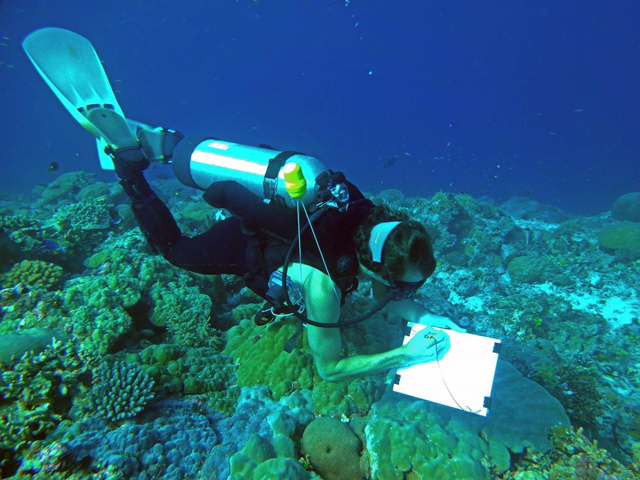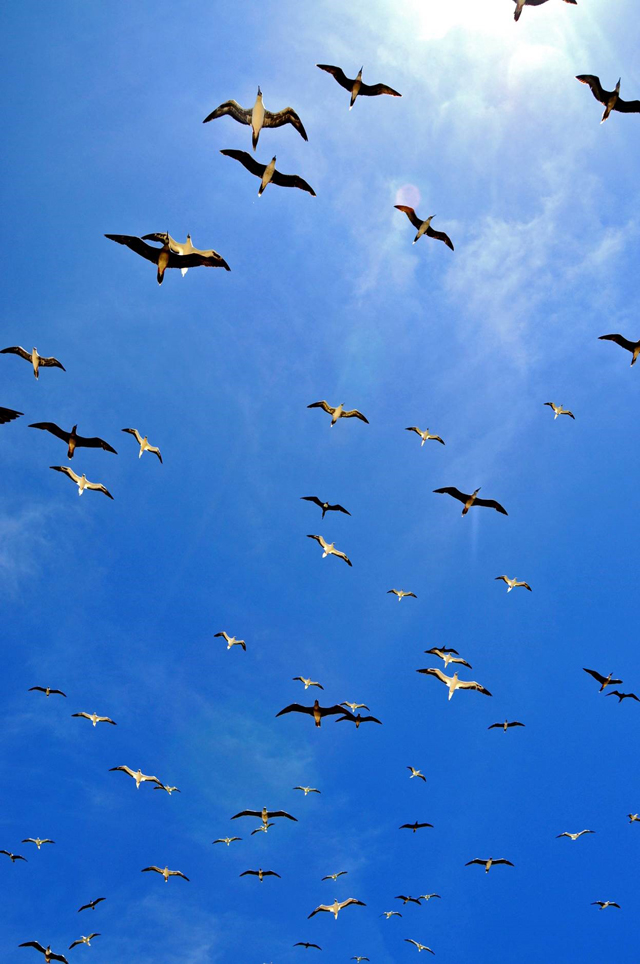Cosmoledo is 'generally healthy'! Island Conservation Society conducts studies on Seychelles atoll
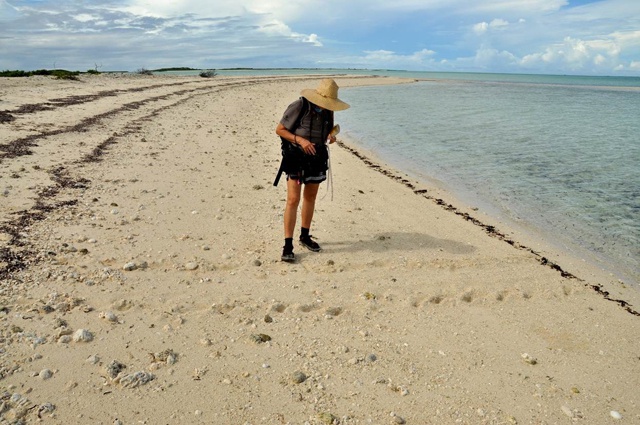
Researcher walks the coast of Grandle Ile on Cosmoledo looking for turtle tracks, and she finds one. (Dr. Sophie Mounier, Island Conservation Society)
(Seychelles News Agency) - Cosmoledo atoll is even more remote and even less visited than Aldabra (110 km to the west) in the Seychelles archipelago of 115 islands. Uninhabited since 1992, Cosmoledo is mostly shallow lagoon and offshore reefs, with 13 small upraised limestone “champignon outcrop” islands forming a ring around the central lagoon.
Cosmoledo, like Aldabra, hosts some of the richest biodiversity in the outer islands in terms of marine turtles, nesting sea birds, fishes and coral reefs.
During the past decade Somali pirate activity further complicated efforts to visit Cosmoledo. But Islands Development Company (IDC) now plans to re-open Cosmoledo in the near future.
So, it was in this context, with the support of the Islands Development Company (IDC), and thanks to the logistical and financial support provided by the owner of the M/Y Pangaea vessel, that a research team from Island Conservation Society (ICS) was able to visit Cosmoledo for a week in March 2014 to conduct baseline and follow-up studies of some of the most important terrestrial and marine ecosystems and species of the atoll.
In this article Dr. Jeanne A. Mortimer, Dr. Gerard Rocamora, Pierre-André Adam, Ahab Downer, and Dr. Sophie Mounier describe the background and objectives of the studies they conducted at Cosmoledo.
Was the 2007 Rat and Cat Eradication Successful?
In 1999, the first ICS ornithological survey of Cosmoledo atoll conducted by Dr. Gerard Rocamora, Dr. Chris Feare, Adrian Skerrett and Majella Athanase revealed the largest seabird colony in Seychelles with over 1.2 million pairs of Sooty terns nesting, and over 20,000 pairs of three different species of boobies across the atoll.
But, these seabirds were threatened by large populations of invasive rats and cats present on the three largest islands of the atoll.
In 2007, in response to this threat, ICS implemented the “Rehabilitation of Islands Ecosystems” project which was co-funded by the Fonds Français pour l’Environnement Mondial (FFEM), with substantial in-kind support from Islands Development Company (IDC), a key purpose of which was to eradicate rats and cats on three of the most important seabird islands of Cosmoledo: Grande Ile, Grand Polyte and Petit Polyte (165ha in total).
This complex operation required several missions and important logistical and technical inputs, including two aerial rodenticide baitings done by helicopter.
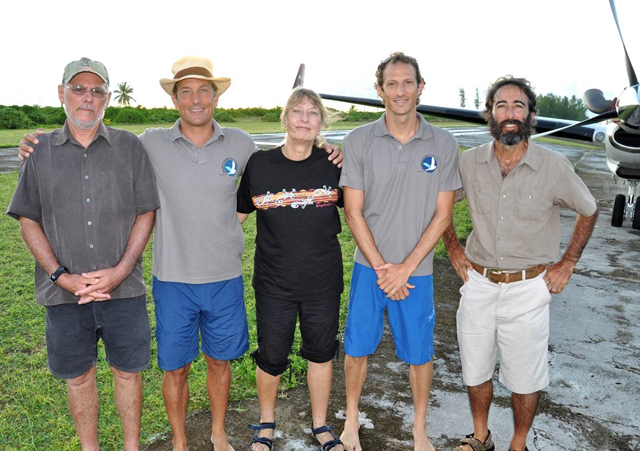 |
| Expedition Members from left to right: Dr. Mike Fay, Ahab Downer, Dr. Jeanne Mortimer, Pierre-André Adam, Dr. Gerard Rocamora (Dr. Sophie Mounier , Island Conservation Society) Photo license: CC-BY |
A year after the eradication, in November 2008, an ICS team conducted an intensive survey trapping mission. Its preliminary findings indicated that the rat eradication had been successful and that cats had died out on Grand Polyte.
But, after a long period of no access to Cosmoledo due to the threat of piracy, further proof was needed to verify that the islands were truly free of rats and cats. The ICS/Pangaea Expedition in March 2014 enabled Dr. Rocamora to spend enough time on Cosmoledo to assess the long-term success of the 2007 ICS eradication project and the recovery of the ecosystem.
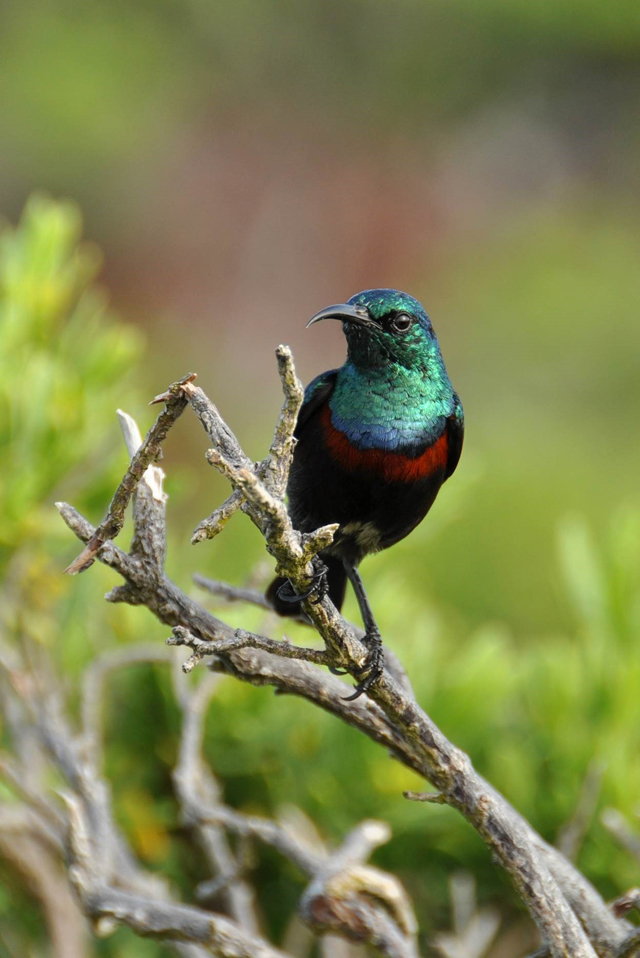 |
| Abbott’s Sunbird (Dr. Sophie Mounier, Island Conservation Society) Photo license: CC-BY |
Sea Turtle Populations
During the 1980s when large numbers of green turtles were being killed legally for meat in Seychelles, Cosmoledo was the site of the heaviest exploitation. Dr. Jeanne Mortimer, who lived with the fishermen and turtle hunters on Cosmoledo for five months in early 1982, estimated that the harvest of turtles at that time was not sustainable in the long term.
Cosmoledo has been uninhabited since 1992, but the turtles have been subjected to occasional illegal poaching raids conducted by the crews of passing ships.
So, one of the objectives of the ICS/Pangaea Expedition was to enable Mortimer to conduct rapid surveys in order to compare numbers of green turtles nesting in March 2014 with what she documented at Cosmoledo three decades earlier in March 1982. She also wanted to evaluate the current importance of Cosmoledo as a foraging habitat for immature sea turtles.
Terrestrial Vegetation
The vegetation of Cosmoledo Atoll had been studied only superficially prior to 2014. This changed when Dr. J. Michael Fay, a globally renowned botanist and conservationist with ties to the National Geographic Society, the Missouri Botanical Gardens, and Wildlife Conservation Society (WCS) joined our ICS/Pangaea Expedition in March 2014.
Dr. Fay intended to produce detailed photographic transects of the vegetation of each of the islands of Cosmoledo and upload them onto Google Earth to make them widely available. Fay also wanted to identify as many of the plant species as possible and to ascertain the relative importance of invasive and native species of plants in the terrestrial ecosystems of Cosmoledo in an effort to assess the functional health of the vegetation.
Coral Reefs
The health of reef-building corals is a topic of great concern throughout Seychelles given the high levels of coral mortality that followed the bleaching caused by the 1998 El Niño event.
An earlier expedition to Cosmoledo conducted by Island Conservation Society (ICS) in collaboration with the Coral Reef Degradation in the Indian Ocean (CORDIO) programme carried out marine surveys to study the coral reefs of Cosmoledo in 2002.
In March 2014, Pierre-André Adam and Ahab Downer did reef surveys at many of the same points surveyed in 2002 in addition to other previously unsurveyed sites. Their objective was to describe and determine changes in the abundance and diversity of the reef building hard coral species, and to assess the success of young colonies of hard corals in recruiting onto the reefs. They surveyed 15 sites, including the 10 sites surveyed in 2002.
Among the questions they asked were: How healthy are these coral reefs in 2014 compared to 2002? Has the species composition changed in 12 years? How abundant are the macro-invertebrates – i.e. sea cucumbers, sea stars, urchins, soft corals, sea anemones, etc.? This information will help in efforts to sustainably manage the marine habitats of Cosmoledo and adjacent areas in the coming years.
ICS expedition findings:
We found that both the terrestrial and marine ecosystems of Cosmoledo Atoll are generally healthy. We will report some of the details of our findings in articles in the local newspaper, Today In Seychelles in the coming weeks.
SNA presents a series of photos by Dr. Sophie Mounier.
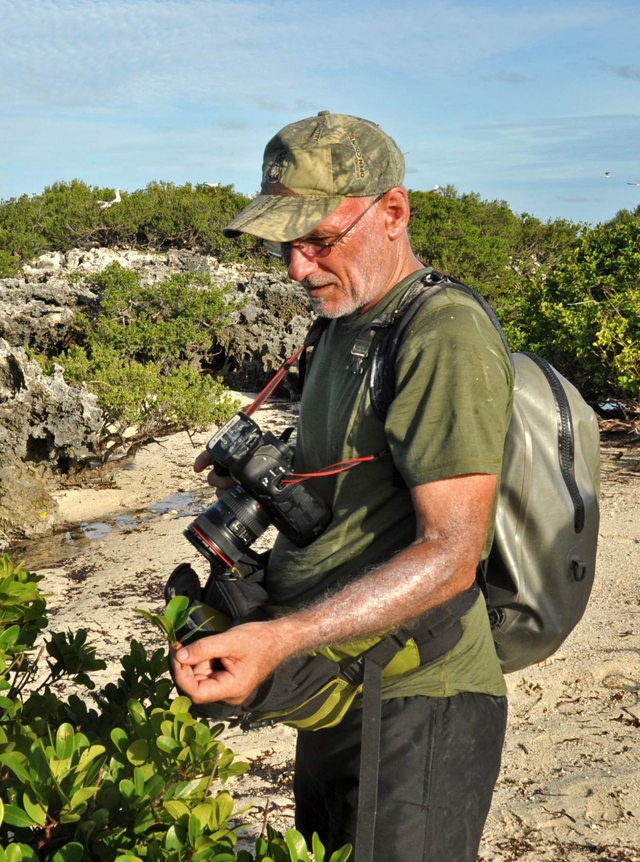 |
|
Pierre-André Adam assessing coral reef at Cosmoledo |
|
Frigate birds and boobies |
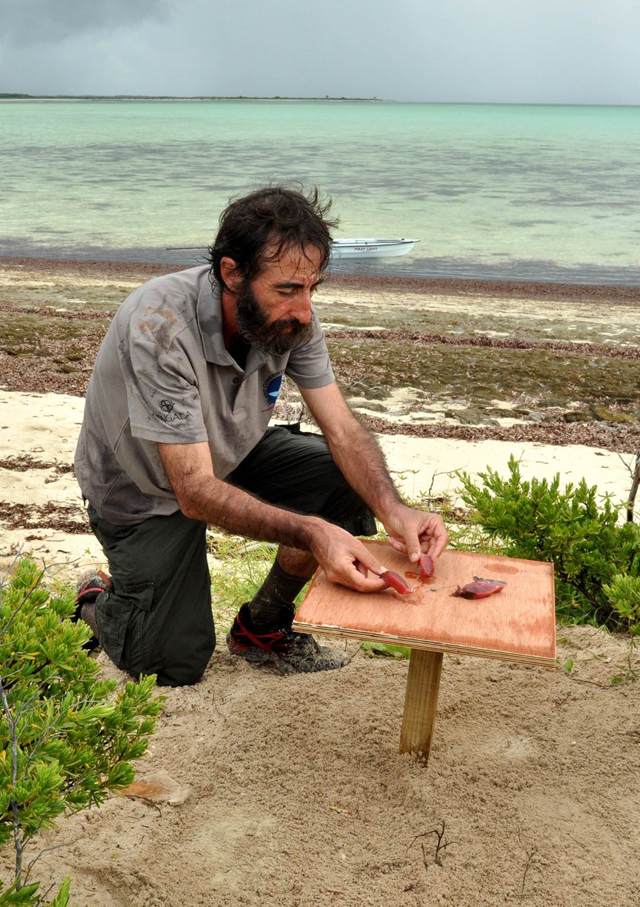 Dr. Rocamora putting out bait for feral cats at Grand Polyte Dr. Rocamora putting out bait for feral cats at Grand Polyte |
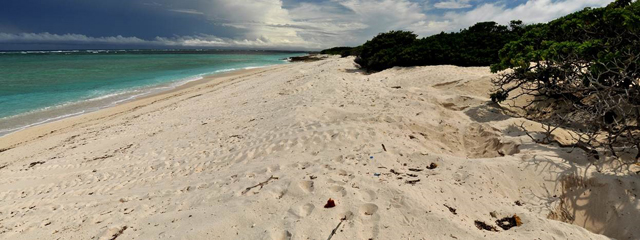 |
| The tracks of a turtle and her nest on Grandle Ile, Cosmoledo (Island Conservation Society) Photo license: CC-BY |


